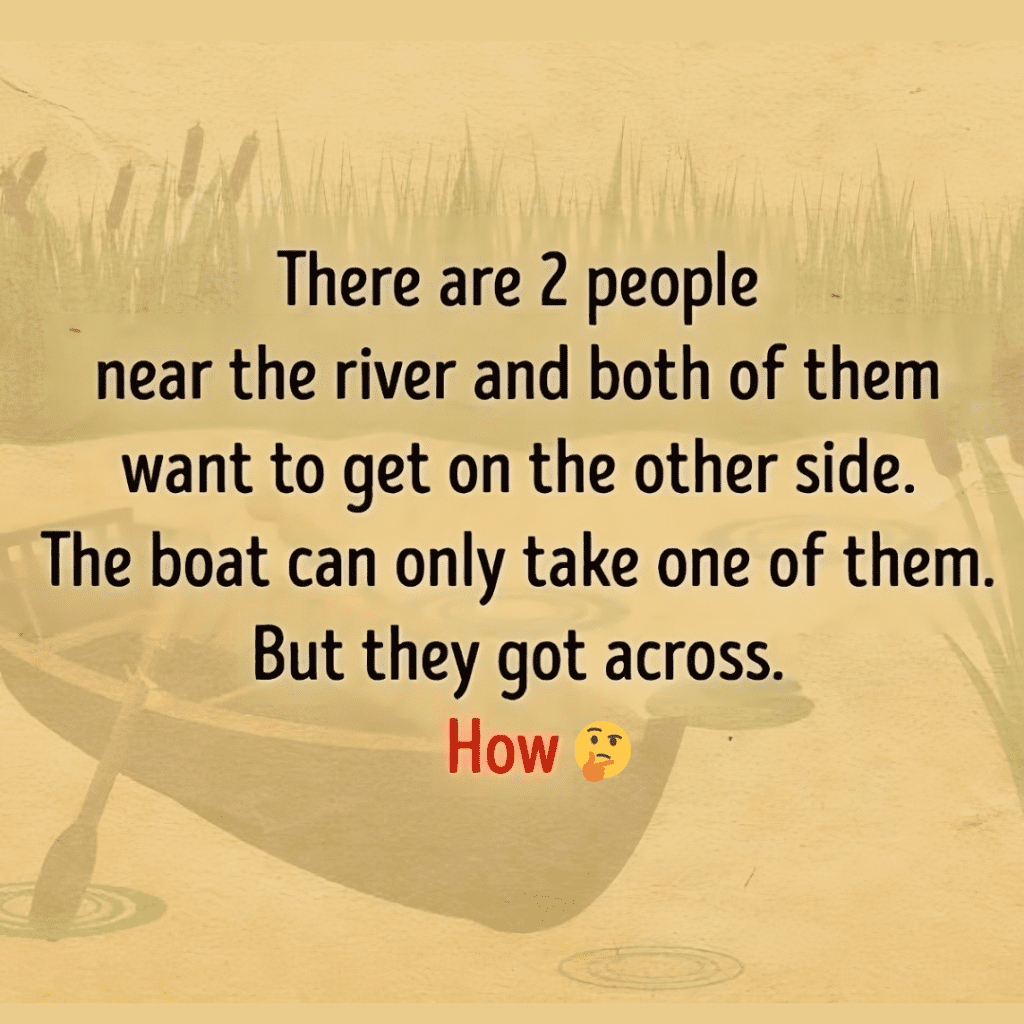“There are two people near a river, and both want to get to the other side. The boat can only take one person at a time.” At first glance, this scenario sounds like it presents an unsolvable problem. But with a little creativity and close attention to detail, we’ll uncover the trick behind this mystery.

The Power of Riddles and Engaging Your Brain
Before we jump into the answer, give yourself a moment to consider the possibilities. Could there be a clever twist in the wording? Are there any clues hidden in plain sight? Riddles like this one are designed to make us question our assumptions, encouraging us to read carefully and look for hidden meaning. They challenge our problem-solving skills, pushing us to think beyond the obvious and avoid overcomplicating the scenario.
Common Missteps That Trip People Up
This riddle is famous for leading people astray. Why? Because our brains instinctively assume both people are starting from the same side of the river. When we read, “Both of them want to get to the other side,” it’s easy to picture them standing side by side, facing a difficult task. But that assumption, while natural, is exactly what causes confusion.
Riddles like this take advantage of our “cognitive bias”—the tendency to jump to conclusions without fully analyzing all the details. In this case, the riddle doesn’t actually say the two people are on the same side of the river. Without considering this possibility, we might try to invent elaborate solutions involving swimming or figuring out ways to defy the rules of the riddle, when a much simpler solution is right in front of us.
Step-by-Step Breakdown of the Solution
To solve this riddle, let’s work through each detail carefully and systematically, so we can uncover the trick that makes it work.
Step 1: Reread the Riddle Carefully
The riddle states, “There are two people near the river, and both want to get to the other side. The boat can only take one person at a time.” Notice that there’s no mention of both people starting on the same side of the river. This detail might seem small, but it’s crucial.
Step 2: Consider the Concept of “The Other Side”
The phrase “the other side” is a key clue. Each person wants to get to “the other side,” but it doesn’t specify that they’re starting from the same place. What if they’re already on opposite sides? This subtle hint opens up the possibility that “the other side” for each person is actually the side where the other person is currently standing.
Step 3: Introduce the Boat into the Scenario
Imagine each person is on a different side of the river, with the boat initially placed with Person A on one bank. Person A can get into the boat, cross the river, and then step out, leaving the boat for Person B on the opposite side.
Step 4: Completing the Crossing for Person B
Now that Person B has the boat on their side, they can get in, cross the river, and meet Person A. In this way, both people have reached “the other side” relative to their starting positions, without the need to be on the same side initially.
Final Answer: They Started on Opposite Sides
The trick to this riddle is realizing that each person started on opposite sides of the river. Since they only needed to make one trip each to reach the other’s starting side, both can successfully cross with a one-person boat
Take the Challenge: Share Your Thoughts and Try More Riddles
Now that we’ve broken down this riddle, what did you think? Did you figure it out before reading the explanation, or did you experience that satisfying “aha!” moment as you read along? Comment below with your initial answer, and let us know if there were any clues that stumped you.
And if you’re feeling inspired, try tackling more riddles to see if you can avoid common pitfalls. Riddles are fantastic tools for strengthening your logical reasoning and keeping your mind sharp. Plus, sharing them with friends and family can turn puzzle-solving into a fun group activity. Challenge your loved ones with this riddle and see if they can avoid the trap of assuming both people started on the same side!
Conclusion: Embrace the Joy of Riddles for Mental Growth
Riddles like this one aren’t just fun—they’re mental workouts that keep us on our toes. They encourage us to question our assumptions, consider alternate perspectives, and find joy in the process of discovery. Whether you solved this riddle right away or needed a little hint, the journey of breaking down the puzzle is often just as rewarding as the solution itself.
So next time you encounter a seemingly impossible riddle, remember that the answer might be hiding in plain sight. Keep challenging yourself, stay curious, and embrace the thrill of solving riddles. With each puzzle you crack, you’re training your mind to think creatively and push the boundaries of conventional thinking. Enjoy the journey, and happy puzzling!


